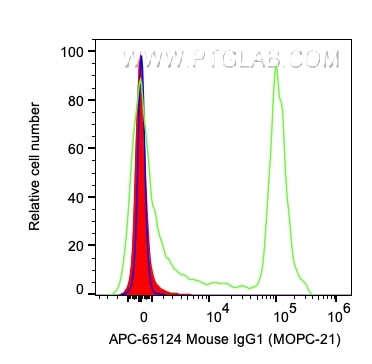Anticorps Monoclonal anti-IgG1 Isotype Control
IgG1 Isotype Control Monoclonal Antibody for FC
Hôte / Isotype
Mouse / IgG1, kappa
Réactivité testée
n/a
Applications
FC
Conjugaison
APC Fluorescent Dye
CloneNo.
MOPC-21
N° de cat : APC-65124
Synonymes
Galerie de données de validation
Applications testées
| Résultats positifs en cytométrie |
Dilution recommandée
| Application | Dilution |
|---|---|
| This reagent has been tested for flow cytometric analysis. It is recommended that this reagent should be titrated in each testing system to obtain optimal results. | |
| Sample-dependent, check data in validation data gallery | |
Applications publiées
| FC | See 2 publications below |
Informations sur le produit
APC-65124 cible IgG1 Isotype Control dans les applications de FC et montre une réactivité avec des échantillons n/a
| Réactivité | n/a |
| Hôte / Isotype | Mouse / IgG1, kappa |
| Clonalité | Monoclonal |
| Type | Anticorps |
| Immunogène | s/o |
| Nom complet | immunoglobulin heavy constant gamma 1 (G1m marker) |
| Symbole du gène | IgG1 Isotype Control |
| Identification du gène (NCBI) | 16017 |
| Conjugaison | APC Fluorescent Dye |
| Excitation/Emission maxima wavelengths | 650 nm / 660 nm |
| Forme | Liquide |
| Méthode de purification | Purification par affinité |
| Tampon de stockage | PBS with 0.09% sodium azide and 0.5% BSA |
| Conditions de stockage | Store at 2-8°C. Avoid exposure to light. Stable for one year after shipment. |
Informations générales
The MOPC-21 immunoglobulin is useful as an isotype-matched control. The MOPC-21 immunoglobulin has an unknown binding specificity and is used as an isotype control for mouse IgG1 antibodies. This antibody has been quality-tested for flow cytometry as negative control.
Protocole
| Product Specific Protocols | |
|---|---|
| FC protocol for APC IgG1 Isotype Control antibody APC-65124 | Download protocol |
| Standard Protocols | |
|---|---|
| Click here to view our Standard Protocols |
Publications
| Species | Application | Title |
|---|---|---|
Carbohydr Polym Plasmablasts induced by chitosan oligosaccharide secrete natural IgM to enhance the humoral immunity in grass carp. | ||
Cell Signal RelB promotes the migration and invasion of prostate cancer DU145 cells via exosomal ICAM1 in vitro. |


